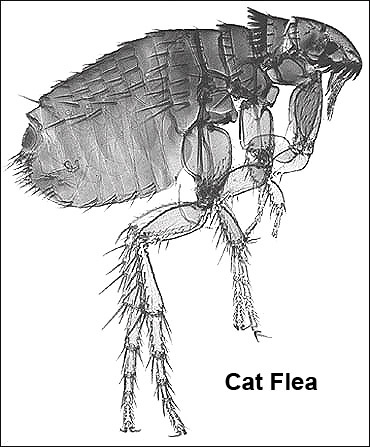 Fleas are of medical importance as vectors. They have been identified as carriers of various rickettsial bacterium that are known to cause diseases like Murine typhus (from the bacteria Rickettsia typhi andRickettsia felis) and the rare Cat flea typhus (from Rickettsia felis). The most historically devastating bacteria carried by fleas is called Yersinia pestis. In humans, it can take the form of pneumonic, septicemic and bubonic plague and is thought to have played a role in some of the highest mortality outbreaks in human history including the Black Death; a plague that devastated about one third of Europe’s population in the twelfth century. Even today, many cases of plague are still reported each year to the World Health Organization. Thankfully, better treatments are available. Medical advancements are providing victims of plague a much better prognosis.
Fleas are of medical importance as vectors. They have been identified as carriers of various rickettsial bacterium that are known to cause diseases like Murine typhus (from the bacteria Rickettsia typhi andRickettsia felis) and the rare Cat flea typhus (from Rickettsia felis). The most historically devastating bacteria carried by fleas is called Yersinia pestis. In humans, it can take the form of pneumonic, septicemic and bubonic plague and is thought to have played a role in some of the highest mortality outbreaks in human history including the Black Death; a plague that devastated about one third of Europe’s population in the twelfth century. Even today, many cases of plague are still reported each year to the World Health Organization. Thankfully, better treatments are available. Medical advancements are providing victims of plague a much better prognosis.
Disease is passed when infected fleas defecate the bacteria while sucking blood. The feces contaminates the bite site and, or, any other fresh skin wounds located within range. Occasionally, some cases may follow inhalation of dried infected flea feces.
Fleas may also serve as intermediate hosts for the hymenolepis, dipylidium, and tapeworms.
Due to salivary proteins the bite of a flea can also cause allergic reactions on the skin.
Essential Flea Facts
Fleas don’t bite until they reach adulthood. Though it isn’t unusual to find them in the carpet, couch cushions or bed sheets, adult fleas will spend the majority of their time on the animal or animals on which they feed. They lay their eggs there too (up to 50 a day). Most of the eggs will fall off of your pet into the carpet, or any of the other favorite places your pet enjoys hanging out. It’s for this reason that it is imperative that you treat both your pet and your pet’s environment. After hatching, tiny worm-like larvae emerge and hide themselves deep in carpet fibers, mattress crevices and underneath the cushions of your furniture where they’ll feed on the accumulated feces (dried blood) of the adult fleas. The larvae transform into pupae inside a silk-like cocoon and will remain there for 2 to 4 weeks. This cocoon is resistant to insecticides making follow up treatments and persistent vacuuming necessary even after fleas are no longer found.
Ridding Your Home of Fleas
If you have pets, the most important step in ridding your home of fleas is to focus your attention on treating the pet’s environment. Neglecting to do so can cause you to miss the highest concentrations of the flea population, i.e., the eggs, larvae and pupae.
If you keep your pet indoors, even if it is only occasionally, begin treatment there.
The following tips are from Mike Potter, the Extension Entomologist from the University Of Kentucky College Of Agriculture and whose website on flea control can be found here.
Before treatment, the pet owner should:
- Remove all toys, clothing, and stored items from floors, under beds, and in closets. This step is essential so that all areas will be accessible for treatment.
- Remove pet food and water dishes, cover fish tanks, and disconnect their aerators.
- Wash, dry-clean or destroy all pet bedding.
- Vacuum! — vacuuming removes many of the eggs, larvae and pupae developing within the home. Vacuuming also stimulates pre-adult fleas to emerge sooner from their insecticide-resistant cocoons, thus hastening their contact with insecticide residues in the carpet. By raising the nap of the carpet, vacuuming improves the insecticide’s penetration down to the base of the carpet fibers where the developing fleas live. Vacuum thoroughly, especially in areas where pets rest or sleep. Don’t forget to vacuum along edges of rooms and beneath furniture, cushions, beds, and throw rugs. After vacuuming, seal the vacuum bag in a garbage bag and discard it in an outdoor trash container.
Insecticide Application
Once fleas become established in a home, insecticides are almost always needed to control them. Always read and follow label directions on the insecticide container. Other than the person performing the application, people and pets should be out of the house during treatment. People and pets should also remain off treated surfaces until the spray has dried. This may take several hours, depending on carpet type, ventilation and method of application. Opening windows and running the fan or air conditioner after treatment will enhance drying and minimize odor.
Treating Your Pets
Your veterinarian offers a number of effective products to treat your pets for fleas and ticks. Pills, collars and “spot-ons” come in varying degrees of potency depending on your pet’s size or breed. Over the counter alternatives may be less potent but can be just as effective. Always read and follow label directions when using any pesticide.


